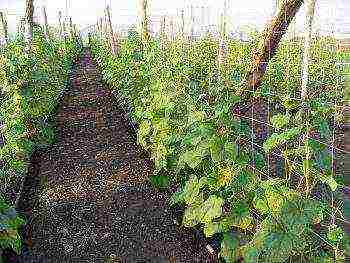Content
- 1 Reproduction and planting of edelweiss
- 2 Edelweiss care and wintering
- 3 Edelweiss flower description
- 4 Edelweiss in landscape design
- 5 The Legend of Edelweiss
- 6 Description of the plant
- 7 Use in garden culture
- 8 Choosing a place and soil for a plant
- 9 Alpine edelweiss: cultivation
- 10 Plant propagation methods
- 11 Alpine edelweiss: we grow a flower from seeds
- 12 External description of the flower
- 13 Gallery: edelweiss flower (25 photos)
- 14 Characteristics of popular varieties
- 15 Features of growing a plant
Edelweiss is a beautiful hardy perennial flower about 30 cm high.In its natural environment, it is found in the alpine and subalpine climatic zone along the rocky slopes of the mountains, but we do not need to look for them in the mountains - edelweiss grows beautifully in the rocky, sandy, well-drained soil of gardens.
They are ideal for covering the soil in mass plantings, in curbs. One contraindication for growing is the high humidity and sultry climate of your region.
Reproduction and planting of edelweiss
Edelweiss from seeds for seedlings at home
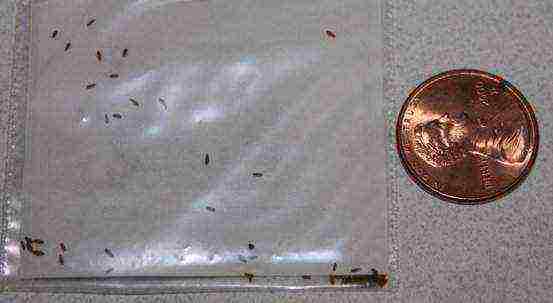
Edelweiss seeds photo
Edelweiss is grown from seeds, more reliably obtained by seedlings.
- In February or March, prepare a mixture consisting of two parts of garden or deciduous soil, one part - perlite, coarse sand.
- Sprinkle the flower seeds on top of the soil, pressing with your palm.
- Pour from a spray bottle, without waterlogging the earth.
- Cover the nursery with foil or glass, keeping the temperature at about 10 degrees.
- When seedlings emerge, remove the cover and place the container with seedlings in a well-lit, warm place.
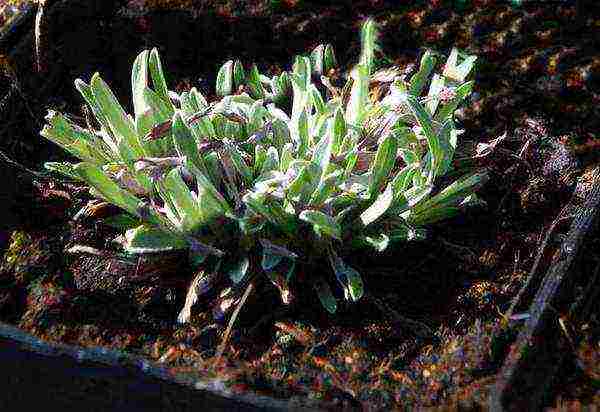
Edelweiss seedlings photo
- Seedlings will grow for a long time, upon reaching 2 cm, the seedlings are planted in separate pots for "growing".
- Water it sparingly, preventing the soil from drying out, but not flooding the plants, otherwise rot will appear.
Seedlings are planted in the ground in late April - early May, keeping a distance of about 15 cm between flowers.
Growing edelweiss from seeds in the open field
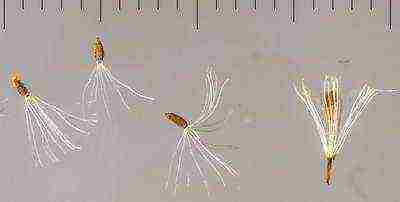
How to sow edelweiss in the open field Photo of seeds
In nature, light edelweiss seeds are carried by the wind and they, clogged in the cracks between the rocky soil, germinate easily even in the absence of soil, if there is enough moisture. Therefore, when sowing, do not deepen the seeds too much, it will be difficult for them to break through the thickness of the earth.
In order not to fool with the seedlings, in the already warmed up soil, without the threat of frost, sow the seeds directly on the site - "alpine hill". The planting depth is 1-2 cm, the distance is as rare as possible, after that you will have to thin out the seedlings, leaving 7-8 cm between them.Grown bushes can be planted less often, leaving 15-20 cm between them.
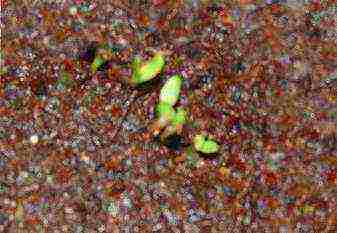
Edelweiss shoots photo
It is recommended for both sowing cases to stratify the seeds for about three weeks - mix the seeds with moist soil and put in the refrigerator in a bag for one to two weeks.
It takes about a couple of months to wait for seedlings, but under suitable conditions, seedlings may appear after a week.
Dividing the bush
Perennial bushes can be divided, acting very carefully, trying to injure the roots as little as possible. Better to use a sharp garden tool or a well-sharpened knife. The bush is carefully dug out, trying not to upholster the ground, and cut into 2-3 pieces with several points of growth. The recommended distance between the resulting plants is 20-30 cm.
Edelweiss care and wintering
- As a mountain flower, edelweiss prefers sunny places with drained, light, limestone, as well as neutral soils with moderate watering.
- It winters well under snow cover, but in the absence of snow, the ground must be mulched before spring comes, it is resistant to spring frosts.
- The flower must be rejuvenated by dividing the bush every 3 years, fed with complex mineral fertilizers in spring, and protected from weeds.
Edelweiss flower description
The plant is completely covered with frequent villi that prevent moisture evaporation, protect from cold weather and give a white-silver "luminous" color. They occupy an area of 15-25 cm, tightly braiding the ground with many roots. Flowering - baskets of white or yellowish flowers without aroma, collected in inflorescences, surrounded by perianths in the form of a star.
It blooms in gardens from June to August, forming small rosettes of leaves by autumn. For propagation, carefully disassemble the tenaciously intertwined roots.
Edelweiss in landscape design
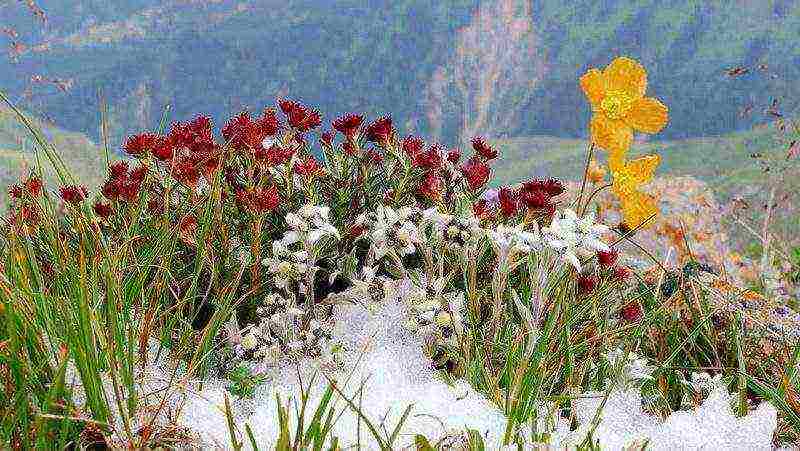
Edelweiss with what to plant Combination with other flowers photo
Edelweiss is great for rock gardens, good for planting in a group, but you should not plant them with bright flowers, otherwise their beauty will be lost.
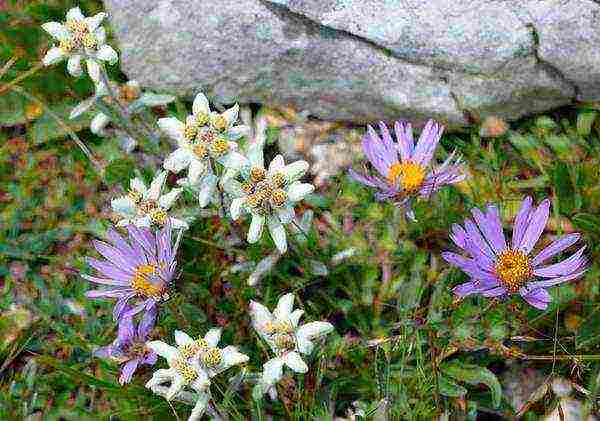
Edelweiss flower description photo with alpine asters
Keeping their color and shape for a long time, they are suitable for dry winter bouquets - cut the flower stalks before opening and dry in a well-ventilated room, hanging the flowers down.

Edelweiss on an alpine slide
Edelweiss is beautifully combined with alpine asters, arctic poppy, juvenile, blackhead, ornamental grasses, heuchera, meadow sage.
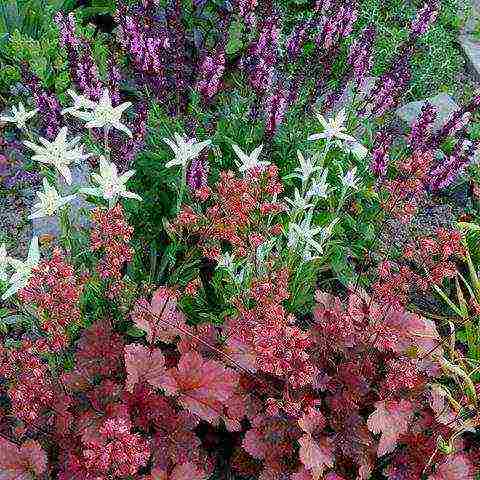
Edelweiss in a flowerbed with other flowers with what to plant
The Legend of Edelweiss
Once upon a time on the tops of the Alpine mountains lived an incredibly beautiful fairy girl who fell in love with a charming young man who lived at the foot of the mountains. The young man could not climb so high into the mountains, and the fairy had no right to go down. The fairy grieved, and the tears rolling down the mountain slopes turned into an extraordinary flower. There are many other legends about the origin of edelweiss, telling about great love, courage and courage, because the places there are harsh! In search of a flower, you need to spend many days in the mountains, so they imagine that if a man gets a flower for his beloved, this means his true feelings and devotion.
The name "Edelweiss" consists of two German words "edel" - nobility and "weiss" - white, which literally means "noble whiteness". This is a truly noble and delicate flower that deserves the attention of florists.
It's good that the miracle flower is now available to everyone, you just have to try a little!
A modest and unpretentious edelweiss is able to decorate even the most demanding alpine slide with its unusual appearance. Translated from Latin, its name sounds like "lion's paw". This is due to the original form of the pubescent flower. One of the many varieties of plants of this genus is alpine edelweiss, the photo of which you see below. It is very decorative, while not so difficult to grow and care for.
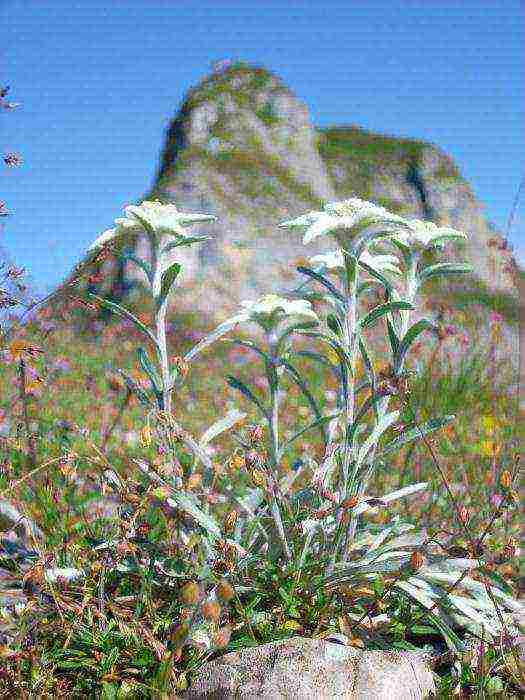
Description of the plant
As you might guess from the name, this species grows in the subalpine and alpine zones of Europe, Asia Minor and Central Asia. The plant can also be found at a lower altitude relative to sea level. However, under such conditions, it loses its decorative tomentose pubescence. Alpine edelweiss grows on exposed limestone, gravelly slopes, rocks and cornices.
It is a herbaceous plant with slightly curved stems that form compact bushes 20 to 30 cm high. In the upper part, they sometimes branch. The edelweiss leaves of this variety are lanceolate, forming a beautiful basal rosette. Flowers of an unusual shape (in the form of a paw) are collected in baskets that form shields. The fruit is achene. Flowering lasts only two weeks in mid-summer.
The whole plant as a whole is very heavily pubescent.Alpine edelweiss has a beautiful silvery green hue. In nature, this property serves as a special adaptation to the alpine cold climate with constant fogs. The plant is often depicted on coats of arms, coins, postage stamps. There are even Roman tombstones of the beginning of our millennium with the image of flowers. Edelweiss is considered a symbol of mountains, inaccessibility, survival.
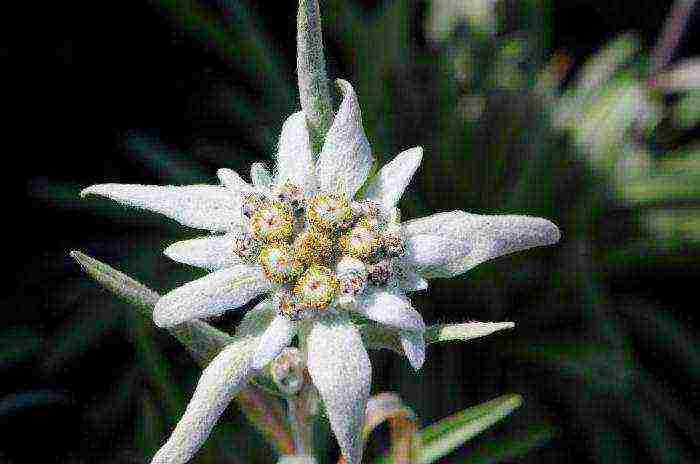
Use in garden culture
Because of its beauty and originality, edelweiss has long been used by humans in gardening. It is especially relevant when creating rock gardens and slides. It looks good when landing in the foreground in small groups. The plant remains highly decorative even after the end of the flowering period. For a long time, cut edelweiss can stand in water. When dried, it does not lose its shape and silvery color, therefore it is often used in winter "dry" bouquets. The best neighbors on slides and in rock gardens will be miniature (dwarf) rose bushes, ageratum, aquilegia, violet and alpine aster.
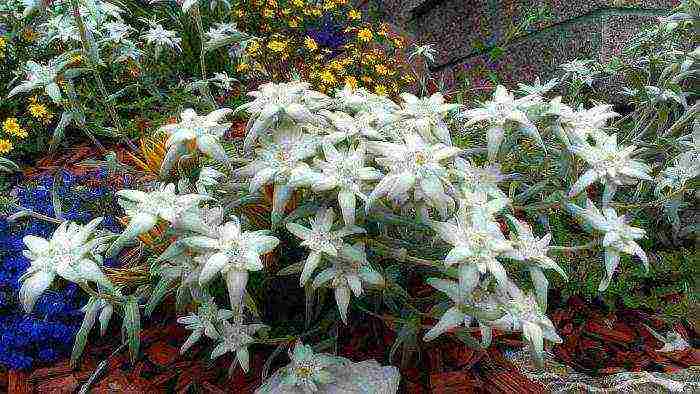
Choosing a place and soil for a plant
It is quite logical that the alpine edelweiss flower prefers well-lit sunny places. The plant is drought-resistant, moreover, it absolutely does not tolerate waterlogging and stagnation of water in the soil. For edelweiss, light, well-drained soils are most optimal.
When planting a plant, it is advisable to add leafy earth, coarse sand or crushed stone. This will help create conditions as close as possible to those in which it grows in its natural environment. Do not use heavy soil, overly nutritious substrates with a high organic content. Together with high humidity, this will lead to a loss of decorativeness of the plant, including beautiful pubescence, strong elongation of shoots.
Alpine edelweiss: cultivation
The plant belongs to the unpretentious category. However, in order to grow it in your garden, you will have to make some effort. At first glance, the flower seems inconspicuous. Indeed, if you plant it in a company with tall perennials, nothing good will come of it. First, there will be little light for him. Secondly, he will simply get lost among them. Edelweiss must be emphasized with a suitable environment, highlighted on the hill with stones, created a small group of plants - only then will it attract the eye.
As mentioned above, the plant does not like excess moisture. Therefore, natural precipitation is enough for him. Moreover, if the summer is very rainy, then it should even be covered. Only in the hot and dry months does the edelweiss need to be watered additionally. The second important component of plant care is weeding, loosening (very superficial, so as not to damage the roots).
Young alpine edelweiss at the age of 1-2 years needs light shelter for the winter. You can use fallen leaves or branches of conifers. In the spring, the shelter should be removed as early as possible so that the shoots are not blocked. The plant thrives on lime-rich soils. Therefore, do not forget to periodically feed it with all the necessary trace elements during the active growing season.
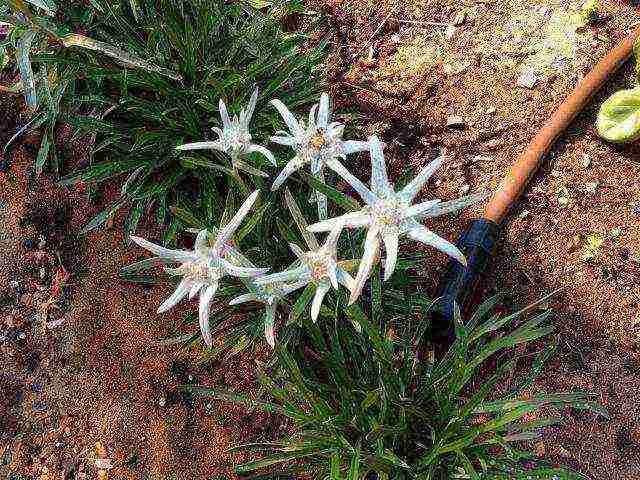
Plant propagation methods
Edelweiss can be propagated in two well-known ways: vegetative and seed. And each has its own advantages. During seed reproduction, the original characteristics of the plant are lost, that is, those that it possessed in the natural growing environment. This leads to the fact that the appearance of the flower is very different depending on the place of cultivation. Therefore, in order to preserve the characteristics of the variety, use the vegetative method. It's pretty simple and straightforward.
Alpine edelweiss is propagated vegetatively in spring or autumn by cutting or dividing the mother bush.In autumn, an adult specimen consists of several annual rosettes, which are very tightly intertwined with roots and, in fact, are independent plants. They are neatly separated and seated in a new place. Young edelweiss will bloom in the next summer after wintering. The tops of the shoots are suitable for cuttings, but not too old. They easily take root in the spring (May-June), and bloom the next summer.
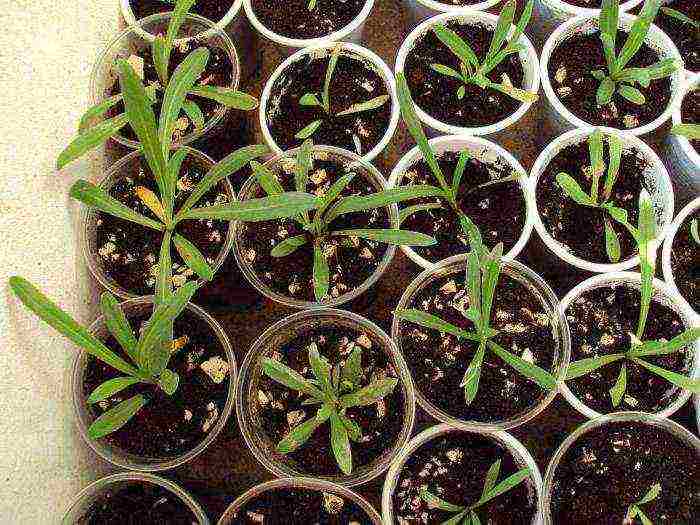
Alpine edelweiss: we grow a flower from seeds
In order to grow a flower, you need to go to the store and buy a bag of seeds. Sowing is carried out in February-March in a light nutritious soil. The container with crops is covered with glass to retain moisture and heat and placed in a shaded place. The germination temperature of seeds is 13-15 ° С, the first shoots can be observed in 2-3 weeks. After there are more of them, the shelter is removed and the container is transferred to a bright place. Seedlings grow rather slowly. The main thing during this period is not to flood them. Plants that have reached a height of 2 cm are planted in separate pots.
Frankly speaking, edelweiss, in comparison with many other flowers, does not amaze at all with its beauty. But this is only at first glance. This small flower is shrouded in many secrets. In particular, it has long been considered a symbol of love, loyalty, courage. Perhaps because once men, risking their lives, tried to get this flower high in the mountains for their loved ones. Therefore, it is not surprising that you so want to conquer this "mountaineer" by trying to grow it on your site. Read this article on how to do it with minimal effort.
Edelweiss, or leontopodium (Leontopodium) - a genus of herbaceous plants of the Asteraceae family, common in the highlands of Europe and Asia.
 Alpine edelweiss (Leontopodium alpinum)
Alpine edelweiss (Leontopodium alpinum)
Content:
- What is edelweiss like?
- Edelweiss care
- Reproduction of edelweiss
- Edelweiss partners
What is edelweiss like?
Not very bright. Therefore, if you plant it among roses, gladioli or phloxes, the edelweiss will simply "be lost." But if you create the appropriate conditions for him on your site, placing it on an alpine slide, it is a completely different matter. By the way, alpine edelweiss can be found only in the Carpathians and the Alps, where it grows at an altitude of 1700-2000 m. There is also a Siberian species - Edelweiss Palibina (Leontopodium palibinianum), growing in the mountains of Siberia, Mongolia and Korea, it is larger than the Alpine.
Alpine edelweiss (Leontopodium alpinum) according to the modern classification is considered a subspecies of Snow Edelweiss (Leontopodium nivale) - Leontopodium nivale subsp. alpinum.
Often the subspecies of the plant “Cat's paw pink” (Antennaria rosea subsp. Confinis) is called the Siberian edelweiss, which is incorrect from a botanical point of view.
The leaves and stems of edelweiss are covered with grayish tomentose pubescence, which protects the plant from excessive evaporation of water - this is how nature wisely decreed. The flowers are mostly snow-white. Inflorescences are baskets collected in dense heads. They are usually surrounded by a "star" of apical leaves. In France, the plant is called the alpine star. At the same time, the inflorescences vaguely resemble a lion's paw print. Therefore, the scientific name - Leontopodium - translated from Greek means a combination of the words "lion" and "leg". The common name "edelweiss" comes from the Greek words for "noble" and "white". Blooms in June and August.
Edelweiss care
Edelweiss does not require any special care. It is a one- or perennial light-loving drought-resistant plant. Prefers light dry calcareous soils, does not tolerate stagnant water. Since this is a real inhabitant of the mountains, when planting, it is advisable to add crushed stone or coarse sand to the soil.
Unlike many other flowers, nutrient soil is not good for edelweiss. From this, he loses decorativeness. At the same time, it feels great on poor soils, in the cracks between stones.
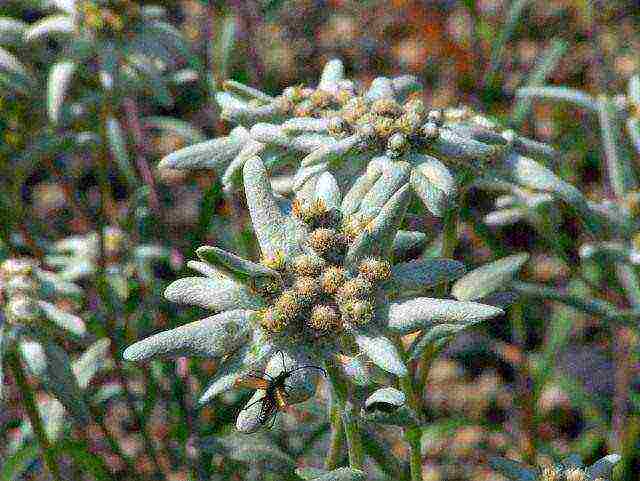 Edelweiss Palibina (Leontopodium palibinianum)
Edelweiss Palibina (Leontopodium palibinianum)
Edelweiss is propagated, most often from seeds, preferably by seedling, sowing it in February-March in a soil mixture of deciduous soil and sand (2: 1). The seeds are not deepened, but scattered over the soil surface. The box is covered with glass or foil, which is removed when shoots appear. Plants grow slowly.
In late April and early May, seedlings can be planted in open soil. Edelweiss can be propagated by dividing the bush in spring or autumn. True, edelweiss bushes are very closely intertwined with roots, therefore, when dividing them, you should disassemble them very carefully. They will bloom next year. Plants can grow in one place for 2-3 years. So that they do not lose their decorative effect, they should be transplanted to another site.
 Snow edelweiss (Leontopodium nivale)
Snow edelweiss (Leontopodium nivale)
The height of the edelweiss is 15-20 cm, so it is so important not to "hammer" it with other plants. Partners for him can only be such low crops as alissum, gypsophila, tenaciousness, sedum and other ground cover plants.
If you manage to grow your own edelweiss, you can deservedly be proud of it. In addition, the plant is listed in the Red Book, and therefore it is necessary to protect it and promote its distribution. In addition, even in winter, edelweiss can delight you with its beauty, since it is often used as a dried flower for composing winter bouquets. At the same time, it retains its shape and silvery color.
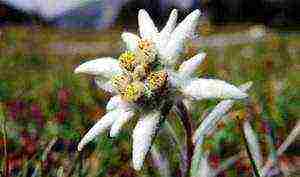 Poets have composed many legends about edelweiss flowers - about courage, loyalty and love. The plant itself resembles miniature nacreous pearls or silver radiant stars, scattered by nature on the rocks of snow-capped mountain peaks. The "Alpine Star" in France, or the "Silver Flower of Rocks" in the Italian Alps, grows on mountain slopes with unenriched soils or on rocky ground.
Poets have composed many legends about edelweiss flowers - about courage, loyalty and love. The plant itself resembles miniature nacreous pearls or silver radiant stars, scattered by nature on the rocks of snow-capped mountain peaks. The "Alpine Star" in France, or the "Silver Flower of Rocks" in the Italian Alps, grows on mountain slopes with unenriched soils or on rocky ground.
External description of the flower
Even an amateur gardener knows what an edelweiss flower looks like. It is a low-growing herb with beige-white flowers and beautiful foliage. Average height up to 35 cm, width - 22. White bracts, framed with yellow edging, reaches 10 cm in diameter. Blossoms of inflorescences are collected in dense heads. Edelweiss gradually expands as it grows thanks to self-seeding and creeping underground rhizomes.
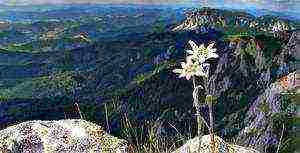 It grows well from both seeds and earthen roots. The flowers are softly pubescent and stand out against the green-silvery foliage. The Latin name was given to the plant for its external resemblance to the paw of a lion.
It grows well from both seeds and earthen roots. The flowers are softly pubescent and stand out against the green-silvery foliage. The Latin name was given to the plant for its external resemblance to the paw of a lion.
The alpine flower looks great against the curbs. Blooming in late summer, edelweiss will delight the owner until the end of autumn. Then the dried inflorescences will be able to decorate festive winter bouquets.
Gallery: edelweiss flower (25 photos)
Characteristics of popular varieties
In floriculture, there are more than 40 plant species. Of these, only five varieties have reached wide distribution:
 Alpine edelweiss... Terry apical leaves fold into a multi-rayed star. The pride of the Alpine edelweiss is the lanceolate, fleecy silver leaves that form a basal rosette. The stem of the plant reaches a height of 20 centimeters.
Alpine edelweiss... Terry apical leaves fold into a multi-rayed star. The pride of the Alpine edelweiss is the lanceolate, fleecy silver leaves that form a basal rosette. The stem of the plant reaches a height of 20 centimeters.- Siberian... A genus close to the alpine grows in the steppe and mountain regions of Korea, Mongolia and Siberia. Large bushes are decorated with miniature inflorescences. The plant develops in permeable, dry and unfertilized soil. Propagated by spring rhizome division or by seeds in summer.
- Pale yellow... Single stems are covered with sparse oblong leaves. The edges of the leaves are rolled up, have a pale yellow or greenish color. The inflorescence star rarely has a regular geometric shape.
- Kuril... The flower, reaching a height of no more than 18 cm, is squat. Straight stems are decorated with drooping felt leaves. Form - narrow lanceolate.
- Bicolor... The difference is soft felt leaves near the inflorescences. Distributed in Japan and Sakhalin.The variety prefers rocky sea slopes and river banks.
Features of growing a plant
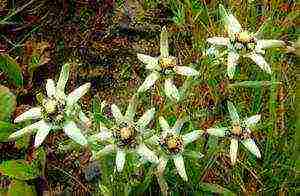 The stereotype that edelweiss only grows high in the mountains has long been refuted. Many modern flower growers cannot imagine a garden without mysterious alpine inflorescences.
The stereotype that edelweiss only grows high in the mountains has long been refuted. Many modern flower growers cannot imagine a garden without mysterious alpine inflorescences.
Useful tips for gardeners
If you decide to grow this beautiful flower in your garden, you should know some of the features of its "character". They will help you avoid mistakes and get a great landscape decoration:
Same
- The flowering time of edelweiss depends on the variety. It can start in June and end in August or even at the very end of autumn.
- When planting in a home area, you should add coarse grained sand or fine gravel due to mountainous origin to the soil. This will make the conditions as close as possible to natural ones.
- Mineral-rich nutrient soil is simply not needed by edelweiss. She will oppress the plant. There will be a loss of decorative properties.
- The optimal fertilizer is humus. It is recommended to apply it in the first weeks of spring, when the flower is at its most weakened.
- Open compositions and sunny locations benefit the alpine flower. It gives many shoots, inflorescences grow larger.
- Edelweiss is resistant to winds and even bright sunlight.
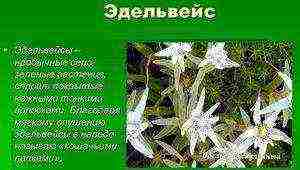 In the wild, all representatives of the alpine flora hibernate under the snow. If the gardener wants to see edelweiss in his rockery, where there is no precipitation, then they need to be mulched, to create an imitation of snow cover. It is recommended to remove the mulch at the very beginning of spring.
In the wild, all representatives of the alpine flora hibernate under the snow. If the gardener wants to see edelweiss in his rockery, where there is no precipitation, then they need to be mulched, to create an imitation of snow cover. It is recommended to remove the mulch at the very beginning of spring.- For a flower, you should carefully choose neighbors. Tall and lush roses, phloxes and gladioli are not the best option, since edelweiss will be lost against their background. Stonecrop, gypsophila and alissum will perfectly fit into the composition.
Breeding methods for edelweiss
It will be easier for beginners and amateurs in gardening to buy ready-made seedlings and start planting them. Experienced growers prefer sowing seeds. Reproduction of Edelweiss has important nuances:
 Parachute seeds fully ready for planting in late February and early March.
Parachute seeds fully ready for planting in late February and early March.- Optimal potting mix consists of deciduous soil and sand in a 1: 1 ratio.
- The seed is not buried inside the soil. It is enough to scatter them over the surface of the box. The container must be covered with glass or tightly with a film that is removed only when the first shoot appears.
- In the first few days May, the seedlings are ready to be transferred to open soil. In the fall, you can propagate a flower by dividing the bush. The only difficulty is the dense, intertwined root system.
- First shoots will begin to break through the ground 2 weeks after landing, if the air temperature is within 16 degrees.
- It is important not to allow waterlogging of the soil - avoid over-watering.
- Edelweiss needs replanting at least once every three years. This helps to maintain and enhance the decorative properties.
Decorative and healing properties
 From ancient times to the present day, edelweiss belongs to the favorite flowers of gardeners. It is suitable for rock gardens, small areas with ornamental plants.
From ancient times to the present day, edelweiss belongs to the favorite flowers of gardeners. It is suitable for rock gardens, small areas with ornamental plants.
Famous botanists Virginie Luss and Jean-Paul Vigneron, studying photographs of edelweiss, found that it completely absorbs ultraviolet rays. A long study of the perianths under an electron microscope provided the necessary information. The alpine plant is covered with the smallest pale villi, entirely composed of parallel cellulose fibers. The average hair thickness is 0.19 micrometers, which is very close to the ultraviolet wavelength.
The protective layer of the villi absorbs radiation that can burn the plant in mountainous areas. But, it transmits visible light, which is necessary for photosynthesis. The discovery allows us to work on new effective sunscreens made from similar nanoparticles. In the future, this will provide full protection of human skin from sunburn.
Due to its strong antioxidant and anti-inflammatory properties, the alpine plant edelweiss is used in folk medicine. Decoctions and infusions from an alpine flower are recognized as effective for rheumatoid pain and diseases of the respiratory system, skin.
Edelweiss is a spectacular plant about which folk songs and legends are composed. "Alpine Star" is suitable for growing in cold climates and stone gardens. The plant not only has an attractive appearance, but is also widely used in medicine and cosmetology.
Attention, only TODAY!
